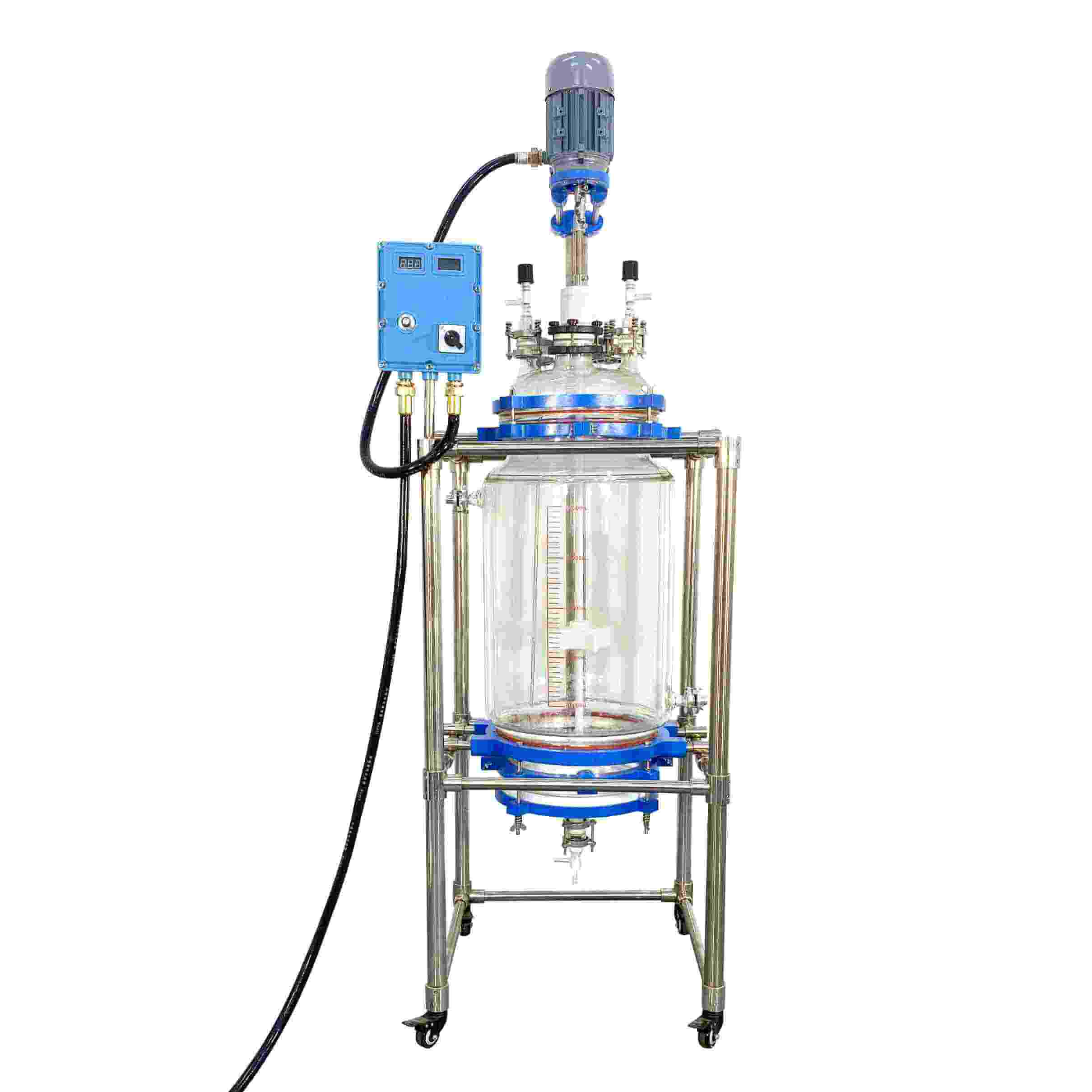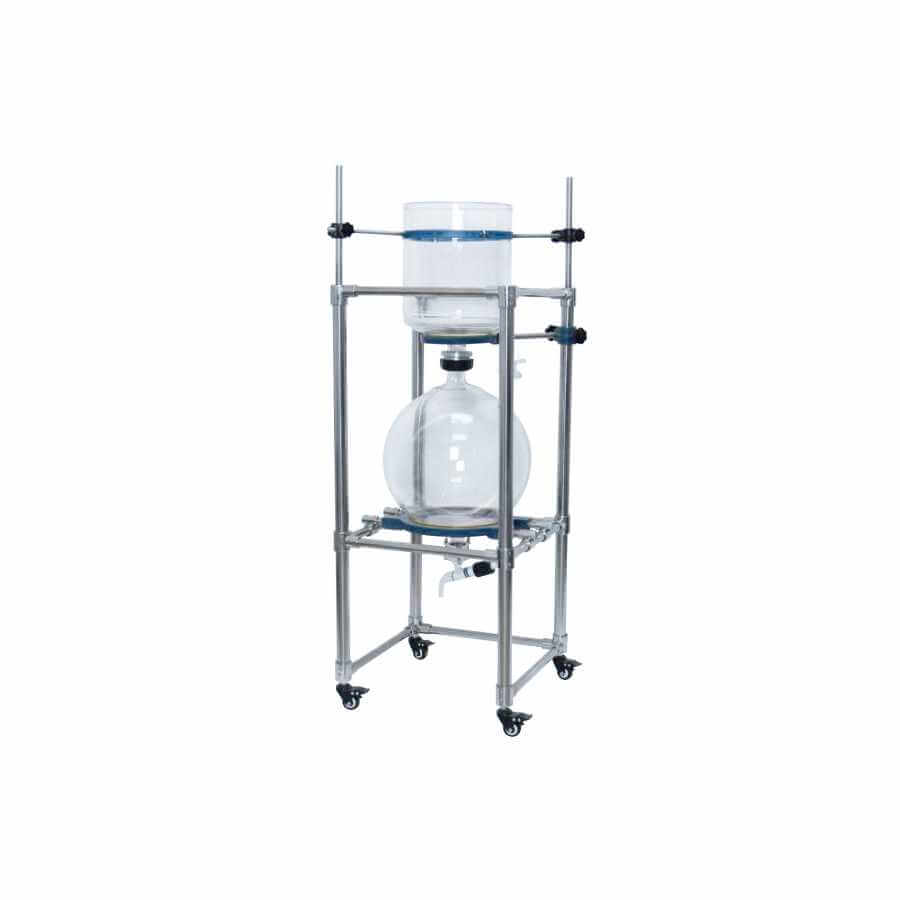

Glass Reactor
Glass reactors: used in chemical reactions, drug research and development, fine chemicals, food manufacturing, and other fields.
Material
glass
Capacity (L)
10-10000+
Mixing system
anchor, paddle, frame and others
Heating system
electric heating, oil heating and others
RUNGYU glass reactors are commonly used biochemical instruments and are widely used in modern fine chemicals, biopharmaceuticals, scientific research and experiments, and other industries. They can be used for concentration, distillation, reflux, separation, and purification reactions under the conditions of constant speed, constant force, and constant temperature. It is an ideal equipment for teaching, experiment, pilot test, and production.
Request a quoteThe first layer is the vacuum interlayer kettle body for heat preservation, and the second layer provides heat and cold for the reaction. The double-layer glass reactor is equipped with a fully transparent reaction bottle, which enables users to understand the reaction process at a glance during the operation. Its discharge valve can discharge concentrated liquid and trace solid materials. The whole material is mainly made of high borosilicate glass material, which has excellent physical and chemical properties, strong corrosion resistance, and maintains the aesthetics and service life of the whole machine.

The chamber and the interlayer jacket of the double-layer glass reactor are designed to have no dead ends, have a certain anti-corrosion and pollution-free structure, and also to ensure the safety and reaction conditions of the entire working reaction. The internal parts of the double-layer glass reactor are also protected by vacuum coating, which has strong corrosion resistance. Users can choose to be fully explosion-proof, safe, and reliable. The heat transfer medium of the double-layer glass reactor can be eliminated after the reaction. No effusion.
The inner container of the double-layer glass reactor is mainly used for placing the reaction materials, which can be vacuumed and stirred at the same time. This kind of reaction equipment can be used for experiments, pilot tests, and production of chemistry, fine chemical industry, and biopharmaceutical new material synthesis. The double-layer glass reactor can be combined with a circulating water multi-purpose vacuum pump, a diaphragm vacuum pump, a circulating cooler, a thermostatic circulator, a low-temperature coolant circulating pump, a closed refrigeration and heating cycle device, etc. to form a system device.
The shell of the double-layer glass reactor adopts a standard aluminum alloy chassis, and its upper cover can be pulled out backward, which is convenient for maintenance and repair.
The panel of the double-layer glass reactor is equipped with a temperature digital display meter, a voltmeter, a tachometer, a control switch, an adjustment knob, etc., which can be easily used by users. The electronic components of the stirring control circuit are all assembled on a circuit board, and the double-layer glass reactor adopts a double closed-loop control system. It has the characteristics of high-speed regulation accuracy, stable rotation speed, and strong anti-interference ability. Protection function, adjust the “speed” knob to change the DC voltage of the DC motor, thereby changing the speed of the motor, to achieve the purpose of controlling the stirring speed.
The user can measure the real-time temperature in the double-layer glass reactor and the jacket through the temperature measuring device. When the temperature measuring device detects that the temperature in the double-layer glass reactor is lower than the set value, the steam regulating valve needs to be opened. When the temperature measured by the temperature measuring device is higher than the set value, the cooling water regulating valve is opened to cool the water temperature in the jacket and reduce the temperature of the materials in the double-layer glass reactor.

Maintenance steps of double-layer glass reactor
1. Before using the double-layer glass reactor, the user must carefully check whether the instrument and the glass bottle are damaged, and also need to check whether the interfaces are consistent and be careful to handle.
2. Use a soft cloth (which can be replaced with a napkin) to wipe each interface, and then apply a little vacuum grease. (Be sure to cover the vacuum grease after use to prevent lime sand from entering.)
3. The interfaces of the double-layer glass reactor should not be tightened too tightly and should be loosened regularly to avoid long-term locking that would cause the connector to be killed.
4. Turn on the power switch first, and then let the machine run from slow to fast. When the machine is stopped, keep the machine in a stopped state, and then turn off the switch.
5. The PTFE switches everywhere should not be over-tightened, which will easily damage the glass.
6. After each use, all kinds of oil stains, stains, and solvent residues left on the surface of the machine must be wiped off with a soft cloth to keep it clean.
7. Unscrew each PTFE switch after stopping, and the PTFE piston will be deformed if it is still working for a long time.
8. Regularly clean the sealing ring, the method is: remove the sealing ring, check whether there is dirt on the shaft, wipe it with a soft cloth, then apply a little vacuum grease, and reinstall it to keep the shaft and the sealing ring smooth.
9. The electrical part must not enter the water, and it is strictly forbidden to get wet.
10. It is necessary to purchase genuine parts from the original factory. The random use of other parts will cause fatal damage to the machine.
11. When doing any repairs or inspections to the double-layer glass reactor, be sure to cut off the power supply and water source first.




